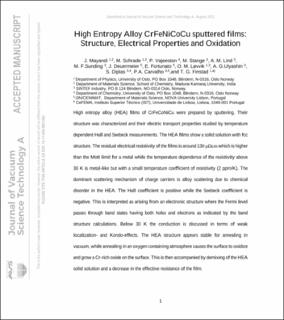| dc.contributor.author | Mayandi, Jeyanthinath | |
| dc.contributor.author | Schrade, Matthias | |
| dc.contributor.author | Vajeeston, Ponniah | |
| dc.contributor.author | Stange, Marit Synnøve Sæverud | |
| dc.contributor.author | Lind, Anna Maria | |
| dc.contributor.author | Sunding, Martin Fleissner | |
| dc.contributor.author | Deuermeier, Jonas | |
| dc.contributor.author | Fortunato, Elvira | |
| dc.contributor.author | Løvvik, Ole Martin | |
| dc.contributor.author | Ulyashin, Alexander | |
| dc.contributor.author | Diplas, Spyridon | |
| dc.contributor.author | Almeida Carvalho, Patricia | |
| dc.contributor.author | Finstad, Terje Gunnar | |
| dc.date.accessioned | 2022-04-01T13:37:50Z | |
| dc.date.available | 2022-04-01T13:37:50Z | |
| dc.date.created | 2022-02-15T16:38:56Z | |
| dc.date.issued | 2022 | |
| dc.identifier.issn | 0734-2101 | |
| dc.identifier.uri | https://hdl.handle.net/11250/2989345 | |
| dc.description.abstract | High entropy alloy (HEA) films of CrFeCoNiCu were deposited by sputtering. Their structure was characterized and their electric transport properties were studied by temperature-dependent Hall and Seebeck measurements. The HEA films show a solid solution with an fcc structure. The residual electrical resistivity of the films is around 130 μΩ cm, which is higher than the Mott limit for a metal while the temperature dependence of the resistivity above 30 K is metal-like but with a small temperature coefficient of resistivity (2 ppm/K). The dominant scattering mechanism of charge carriers is alloy scattering due to chemical disorder in the HEA. The Hall coefficient is positive while the Seebeck coefficient is negative. This is interpreted as arising from an electronic structure where the Fermi level passes through band states having both holes and electrons as indicated by band structure calculations. Below 30 K, the conduction is discussed in terms of weak localization and Kondo effects. The HEA structure appears stable for annealing in vacuum, while annealing in an oxygen-containing atmosphere causes the surface to oxidize and grow a Cr-rich oxide on the surface. This is then accompanied by demixing of the HEA solid solution and a decrease in the effective resistance of the film. | en_US |
| dc.language.iso | eng | en_US |
| dc.publisher | AIP Publishing LLC | en_US |
| dc.title | High entropy alloy CrFeNiCoCu sputter deposited films: Structure, electrical properties, and oxidation | en_US |
| dc.type | Peer reviewed | en_US |
| dc.type | Journal article | en_US |
| dc.description.version | acceptedVersion | en_US |
| dc.rights.holder | This article may be downloaded for personal use only. Any other use requires prior permission of the author and AIP Publishing. This article appeared in Jeyanthinath Mayandi, Matthias Schrade, Ponniah Vajeeston, Marit Stange, Anna M. Lind, Martin F. Sunding, Jonas Deuermeier, Elvira Fortunato, Ole M. Løvvik, Alexander G. Ulyashin, Spyros Diplas, Patricia A. Carvalho, and Terje G. Finstad , "High entropy alloy CrFeNiCoCu sputter deposited films: Structure, electrical properties, and oxidation", Journal of Vacuum Science & Technology A 40, 023402 (2022) https://doi.org/10.1116/6.0001394 and may be found at https://avs.scitation.org/doi/10.1116/6.0001394 | en_US |
| dc.source.volume | 40 | en_US |
| dc.source.journal | Journal of Vacuum Science & Technology. A. Vacuum, Surfaces, and Films | en_US |
| dc.source.issue | 2 | en_US |
| dc.identifier.doi | 10.1116/6.0001394 | |
| dc.identifier.cristin | 2001960 | |
| dc.relation.project | Norges forskningsråd: 245963 | en_US |
| dc.relation.project | Norges forskningsråd: 197405 | en_US |
| dc.relation.project | Norges forskningsråd: 275752 | en_US |
| cristin.ispublished | true | |
| cristin.fulltext | postprint | |
| cristin.qualitycode | 1 | |
